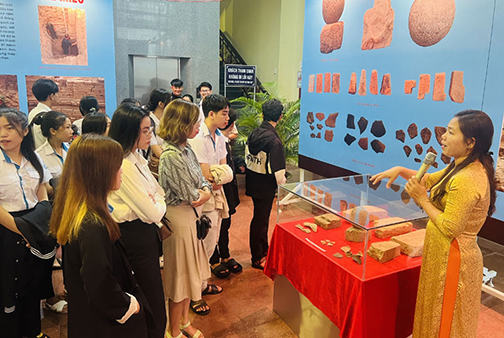The Thematic exhibition of archaeological relics, messages from the ground (from November 22nd to December 22nd, 2022) at the Provincial Museum attracts a large number of public to visit. This is one of the activities to celebrate Vietnam Cultural Heritage Day (November 23rd).

Students listening to the narrator introducing some types of archaeological relics at the Provincial Museum
At the exhibition, with original images and artifacts, the Provincial Museum selected and introduced a number of types of archaeological remains collected through excavations at Eo Bong in Son Thanh Dong commune and Ba Mountain in Hoa Phong commune (Tay Hoa district); Oc hill belonging to Xuan Binh commune and Dinh hill belonging to Xuan Loc commune (Song Cau town); Thanh Ho and Dong Mieu belonging to Phu Hoa town (Phu Hoa district) and An Tho citadel belonging to An Dan commune (Tuy An district).
From stone age relics, to relics belonging to Sa Huynh culture, Champa culture, Dai Viet culture of the Nguyen dynasty, etc., all are physical evidences that bring important messages about history and society, reflecting the process of forming residential communities, and the activities of living, production labor, culture and beliefs of the communities in Phu Yen land.
Mr Tran Cong Hoa, Secretary of the Youth Union of Phu Yen Vocational College, in teaching history at school today, held the opinion that increasing students' exposure to historical documents outside of textbooks, especially those in museums are multifaceted significant. Studying history at the museum will train students with historical thinking skills, such as observation, imagination, subject practice skills, overcoming the situation of impracticality, history modernizing diseases. Above all, studying at the museum also makes students excited to learn about history, fosters the students with pride in the traditions of their homeland and country, etc. Bringing students to the museum also educates them in the sense of respecting and preserving the nation's precious cultural heritages.
Mr Doan Phuoc Thuan, former Chairman of Phu Yen Antiquities Research and Collection Club, said that the display of archaeological relics at the Provincial Museum contributed more evidence for the national and international public to know about Phu Yen land with a long cultural history, with those who know how to cherish the cultural values of their ancestors and forefathers, jointly preserving, conserving, and promoting the national cultural heritage. According to Mr. Thuan, at present, Phu Yen as well as major provinces and cities in the country have established antiquities collection associations. However, in addition to the Phu Yen Antiquities Research and Collection Club, if the province has more heritage associations, it will contribute more to improving the preservation and protection of national cultural heritage.
Phu Yen province is the convergence of many archeological cultures, reflected in the existence of a system of archaeological sites discovered and studied throughout the province. Over the past time, from the results of archaeological excavations, the Provincial Museum has received, preserved and kept a large number of relics, with rich and diverse types, belonging to many different ages, containing historical, cultural and scientific values.
“Archaeological relics are the basis for reconstructing historical and past pictures in a realistic and vivid way; supplementing and strengthening scientific arguments in the activities of researching and disseminating historical and cultural knowledge; is the evidence to make clearer on historical issues that are not recorded by written historical sources, along with contributing to the formation and affirmation of the cultural identity of a land. The archaeological relics at this exhibition help us better understand the history of the land of Phu Yen we live in, thereby adding pride and contributing to the conservation and promotion of cultural heritage values to serve contemporary life”, emphasized Mr. Nguyen Huu An, Director of the Provincial Museum.
Translated by Trinh Thuy